Lenovo Yoga Book 9i review: wonderfully weird or weirdly wonderful?
Lenovo's double-screen laptop has some moments of magic, but moments that'll make you moan too
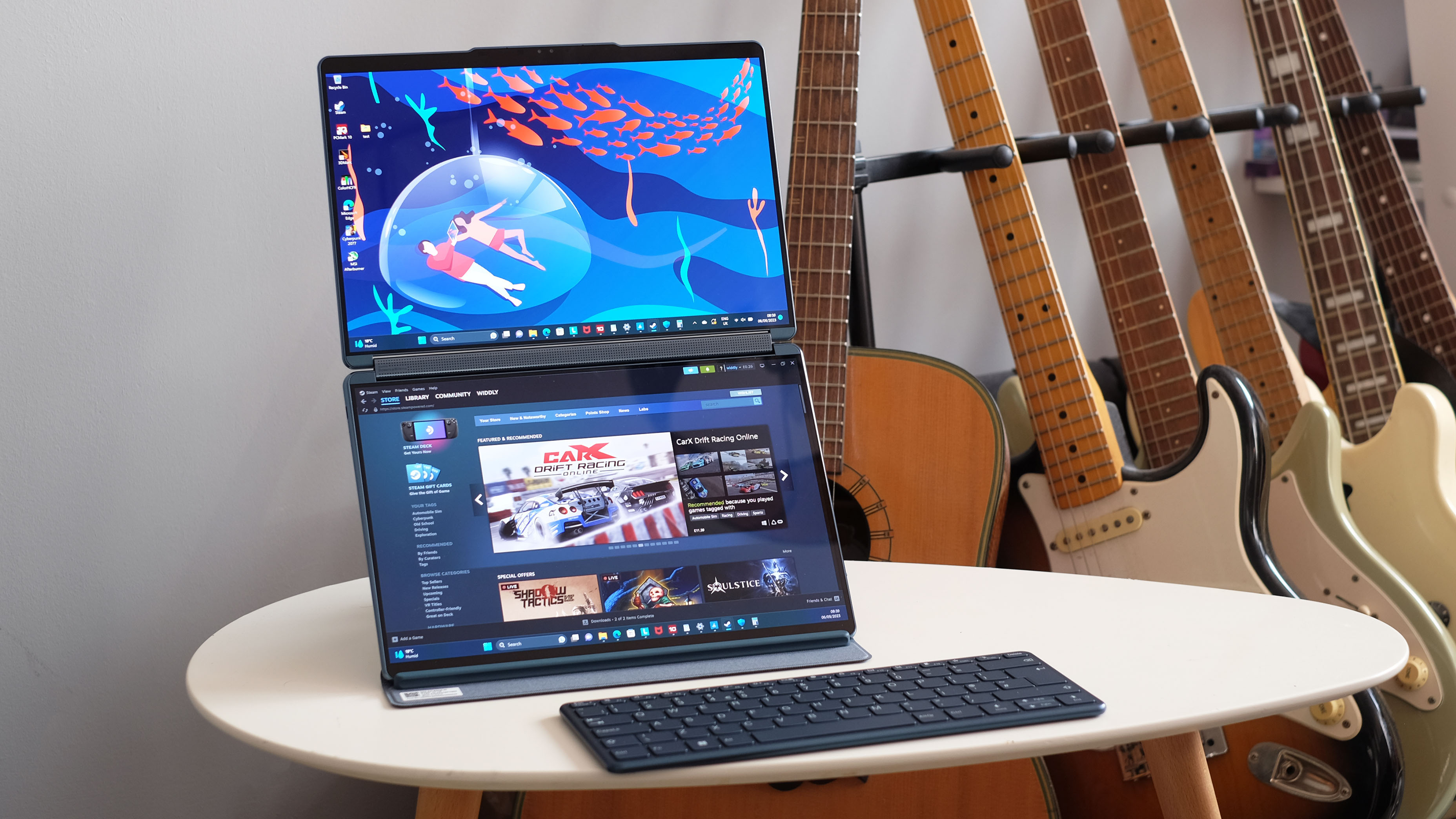
Laptop designs don’t get much more ambitious and out-there than the Lenovo Yoga Book 9i. It’s at its best when acting like a dual-screen PC you can take to hotels and offices across the world. But it isn’t quite as appealing when you just want a portable computer to get stuff done, wherever you are.
-
+
Bold OLED screens
-
+
Decent keyboard accessory
-
+
Can almost feel like a dual-screen desktop PC
-
-
Using screens alone for work is not much fun
-
-
Poor virtual touchpad experience
-
-
The cost of novelty is high
Why you can trust T3

Laptop makers are always trying to find what the next incarnation of the portable computer looks like. Foldable, rollable, lighter than a bag of flour? It’s all been tried, but the Lenovo Yoga Book 9i takes a different approach.
This is less your classic laptop-tablet hybrid, and closer to a marriage of the desktop PC and laptop. Folded up, the Lenovo Yoga Book 9i looks just like a laptop with the world’s flattest keyboard. But opened up and set up in the right position, its two inner screens start to look just like those of a dual monitor workstation array. Sort of.
Will the teething troubles of this ambitious laptop overshadow the good parts? They may well do for many, but we reckon Lenovo would freely admit the Yoga Book 9i isn’t meant for absolutely everyone, certainly not when considering its significant asking price.
Lenovo Yoga Book 9i: Price & Availability
Which brings us straight to that point: the Lenovo Yoga Book 9i costs a fair packet. That's the price of advanced technology, really. The model on review here is £2299 in the UK. It's not much less in the USA either, although you can find it for $1999 in some locations. The real-time shopping widget above will give you a gateway to the current best prices.
Lenovo Yoga Book 9i review: Design
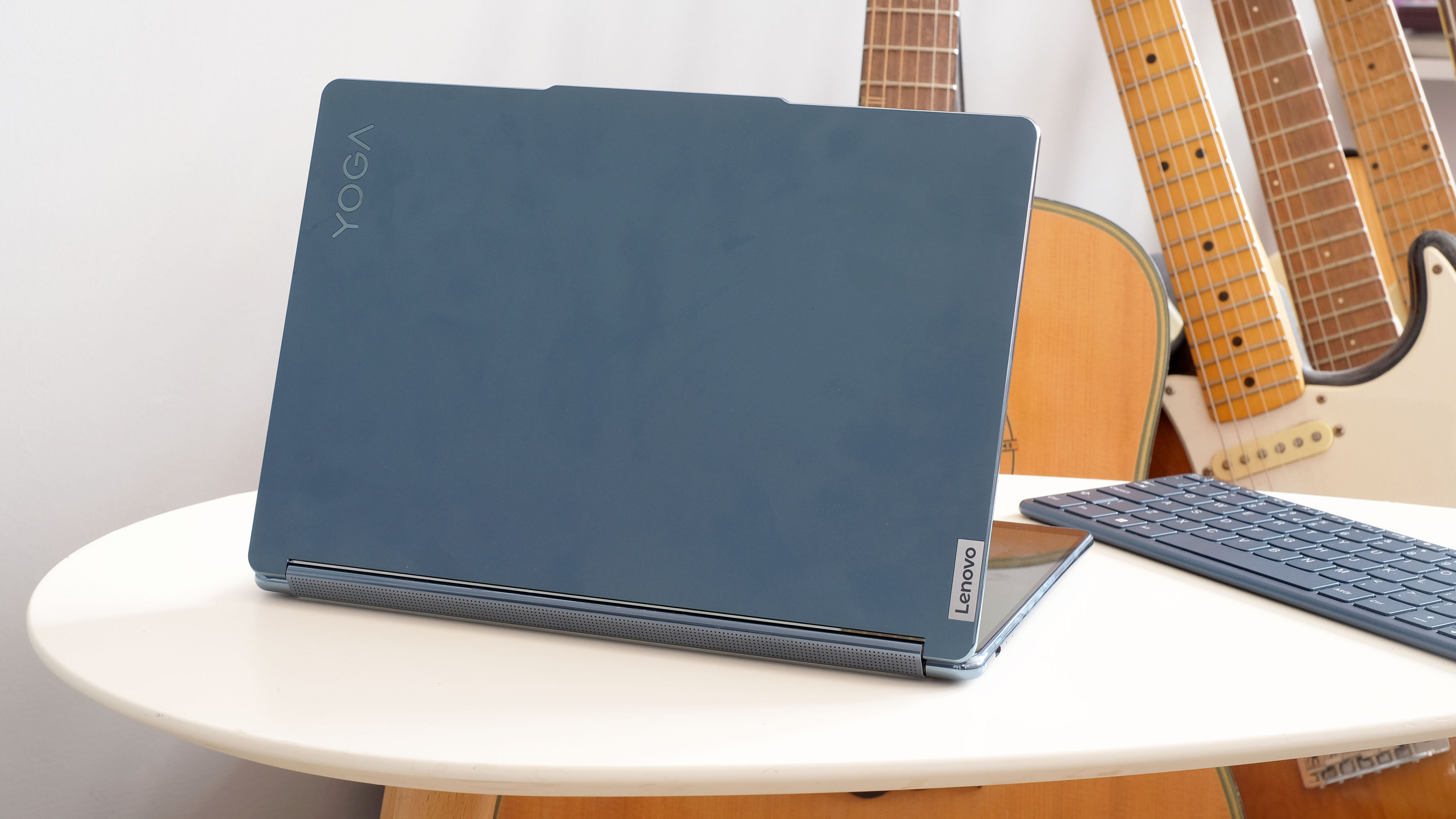
If you took the classic 360-degree hybrid laptop design and amped up its hybrid nature a few dozen notches you might end up with the Lenovo Yoga Book 9.
It has a 360-degree hinge, but a second screen sits where the keyboard usually would. The least appealing way to use the Lenovo Yoga Book 9i is as a laptop, really, with the lower screen acting as a virtual iPad-style keyboard.
Unless you’re not going to be typing little more than numbers into a calculator app, we don’t recommend this style of use. However, it does include a wireless keyboard accessory that can sit right on the lower screen.
Alternatively, you can prop the Lenovo Yoga Book 9i up on its side, like the 'book' of its name, and use it as two portrait PC displays.
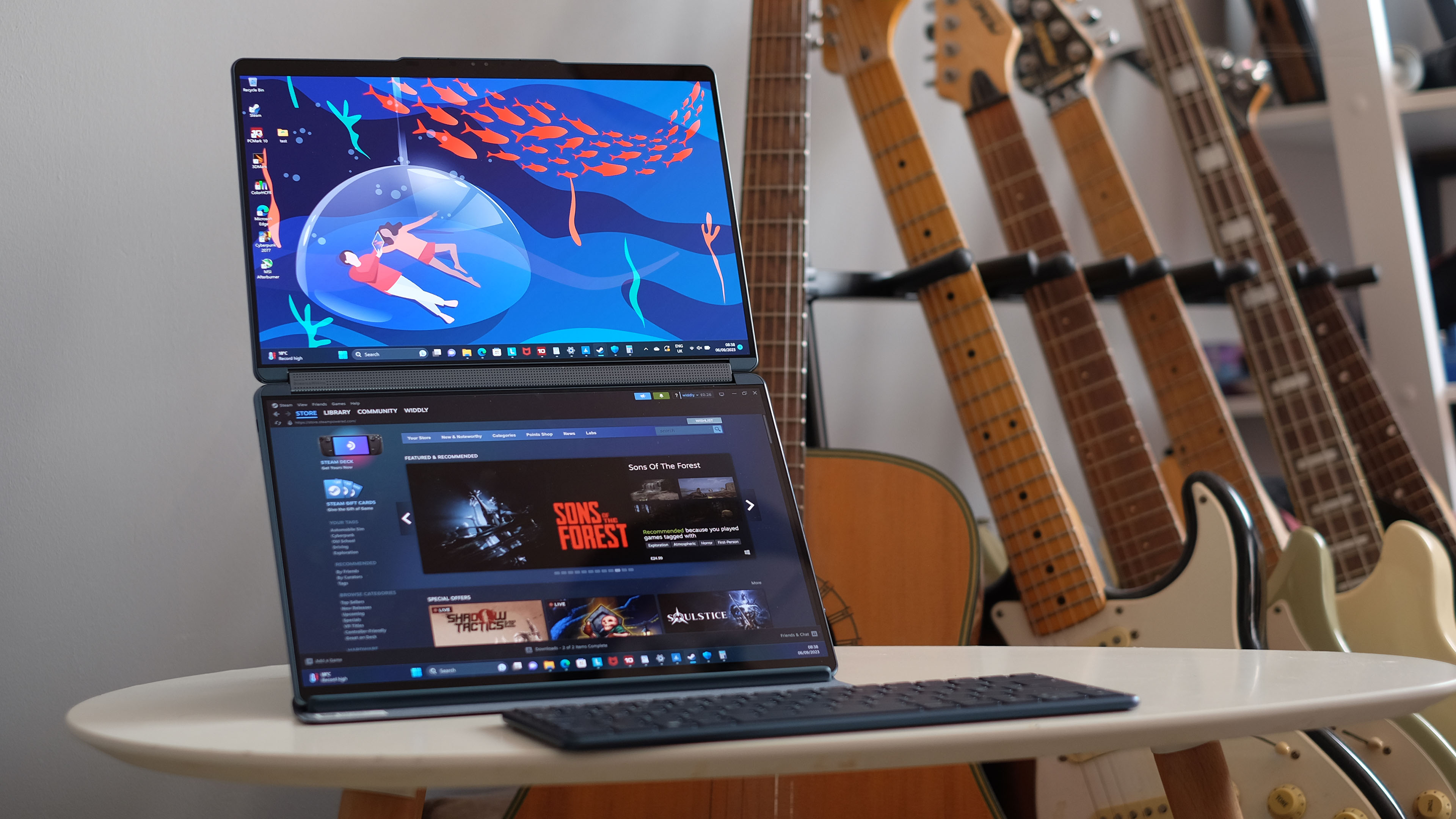
The ideal scenario, though, is with one screen on top of the other. And your first reaction to this may be “how the hell does that work?” One of the panels appears to tower over the other, defying gravity. Looks around the back, though, and you’ll see there’s a folio-style case holding the whole thing together.
When the Lenovo Yoga Book 9i is arranged like this, it can feel oddly close to a dual-monitor arrangement. Both have that landscape aspect ratio most applications expect. It’s a workable solution.
However, for most of us it’s just not going to be as convenient as a normal laptop. That's because you have three parts rather than one — main unit, solid case, keyboard — and you can’t just push the thing closed, laptop-style, as you’ll slam the screen down onto the keyboard bit.
One of the big questions you need to ask yourself is if this stuff will annoy you. Or maybe it is far outweighed by the whole Transformers-style appeal of the thing.
Looking beyond the USP, the Lenovo Yoga Book 9’s metal and glass design is suitably expensive-looking, and has rounded off edges for a softer feel. The weight is also a thoroughly respectable 1.34kg, although that’s minus the keyboard and folio case part.
Lenovo Yoga Book 9i review: Displays
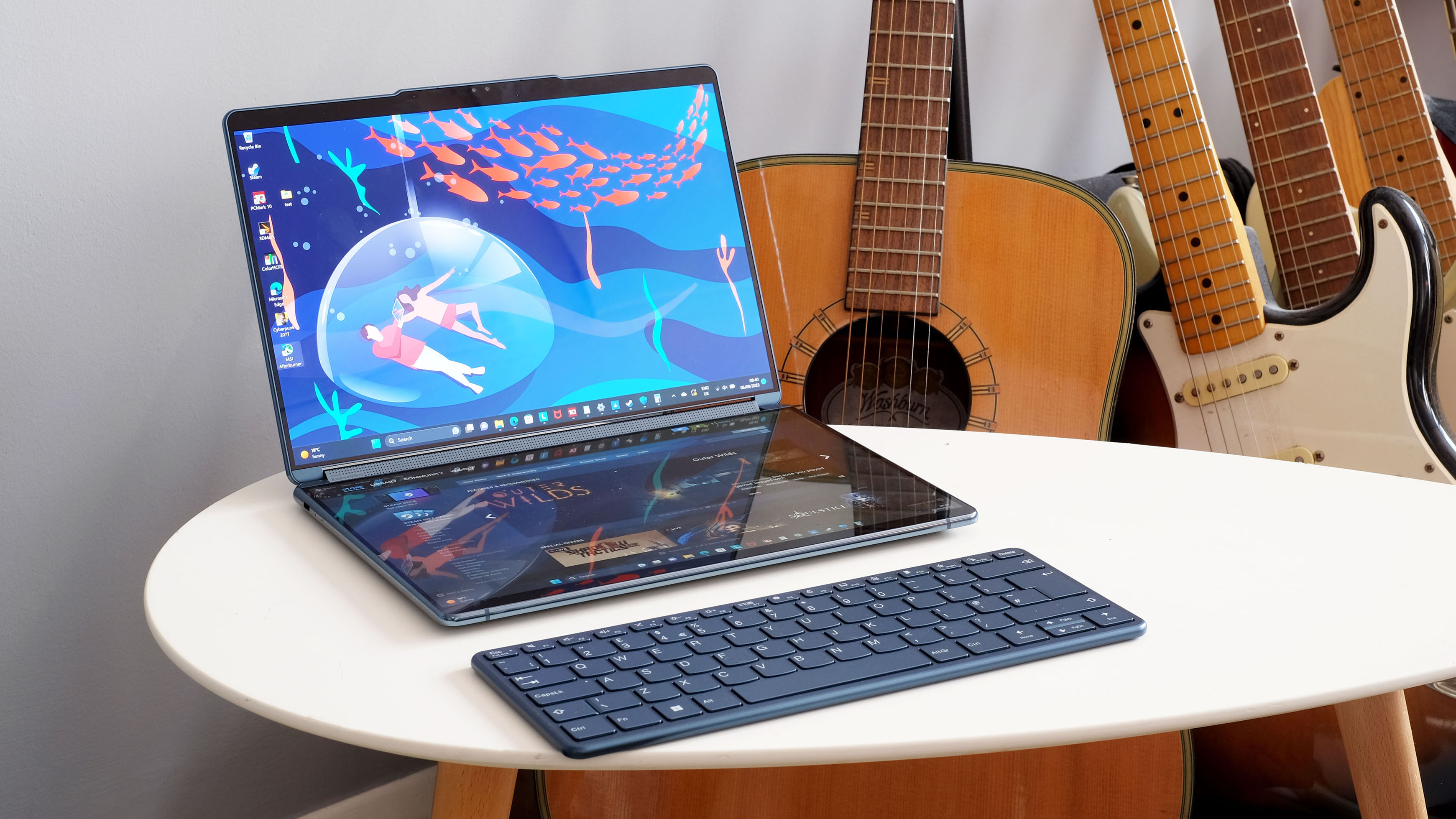
The Lenovo Yoga Book 9’s actual screens are great. These are two 2880 x 1800 pixel 13.3-inch OLED panels with glass-topped surfaces and touchscreen support.
All the usual strengths of OLED are here to see. The Lenovo Yoga Book 9i has ultra-deep colour and black levels, for supremely poppy images that jump off the screen.
The two displays are evenly matched. While the colour of one panel can look slightly different to another thanks to the varying angles you’ll sometimes view them from, it’s the sort of effect you’ll only notice if you go looking for it.
Brightness is only the premium laptop norm, though. We’re starting to see Windows laptops with incredibly bright screens, such as the miniLED Lenovo Yoga 9 Pro. But OLED laptop panels haven’t quite caught up with this kind of power level yet.
Perhaps it matters less than you might initially guess, though, given the Lenovo Yoga Book 9i doesn’t shine in its most portable form, as you ideally want to be able to use the keyboard accessory when working outdoors.
These screens also support a stylus, which is included. This doesn’t slot into the bodywork, but does tamp up the Yoga Book’s design and art cred nicely, even if it doesn’t become a single giant canvas like the foldable Asus Zenbook 17 Fold OLED’s display. Still, that giant doesn’t support a stylus, making it a no-go for pen-led digital art.
Lenovo Yoga Book 9i review: Keyboard & touchpad
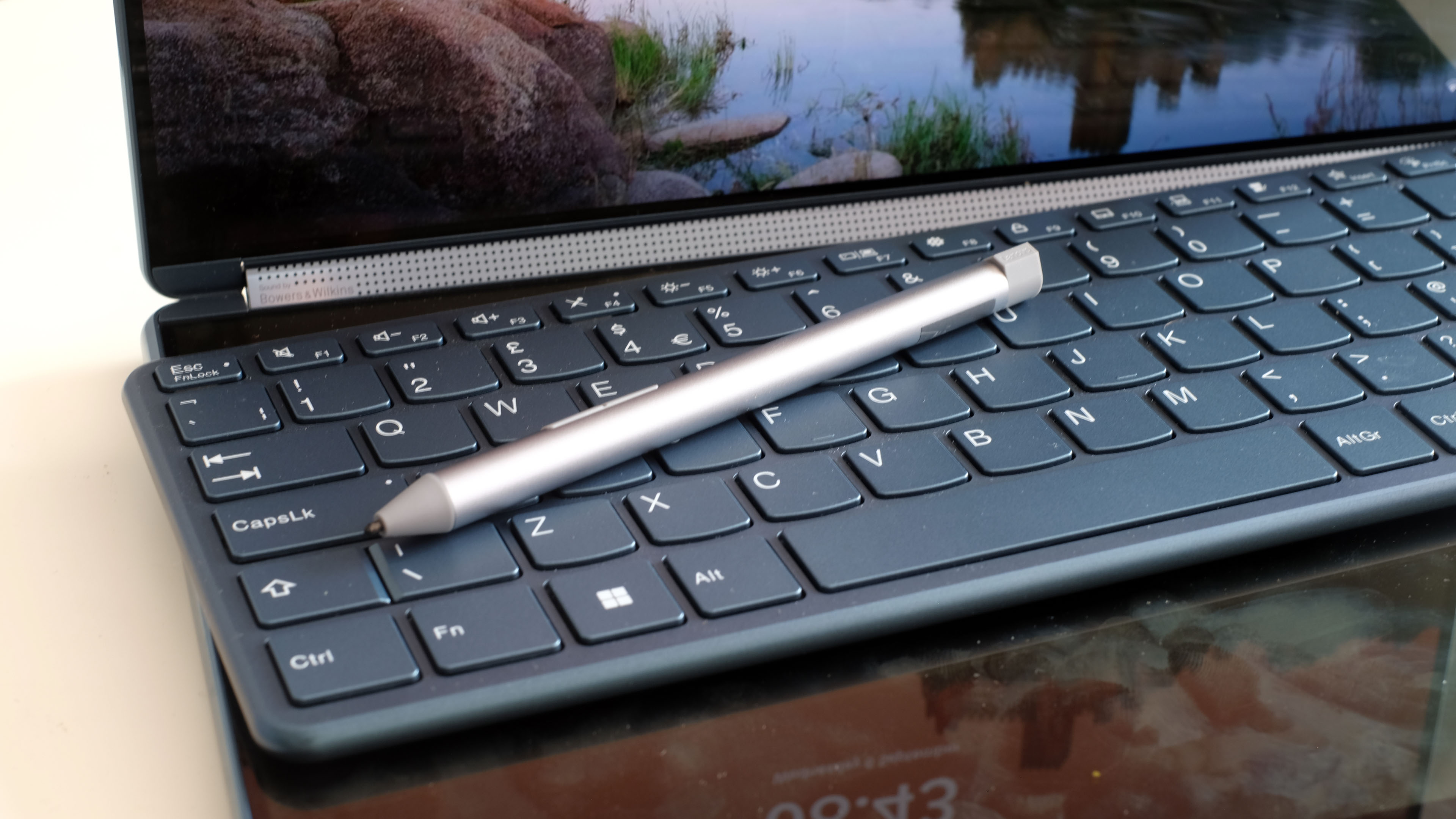
The whole Lenovo Yoga Book 9i input situation is a story of two halves. There’s when it’s used with the keyboard accessory, and when it isn’t.
We are not fans of using the lower screen as a virtual keyboard and touchpad at all. There’s a mode specifically for this, as a virtual touchpad appears when you place the keyboard in the lower screen, where a laptop keyboard is usually found.
While the best laptop touchpads are made using glass, it’s totally different to the glossy glass of a classic touchscreen.
Laptop pads use textured glass, designed to reduce friction for a smoother finger glide. It makes input feel faster and more precise, where the Lenovo Yoga Book 9’s virtual pad feels very odd, even though we do spend hours a week prodding the touchscreens of tablets and phones.
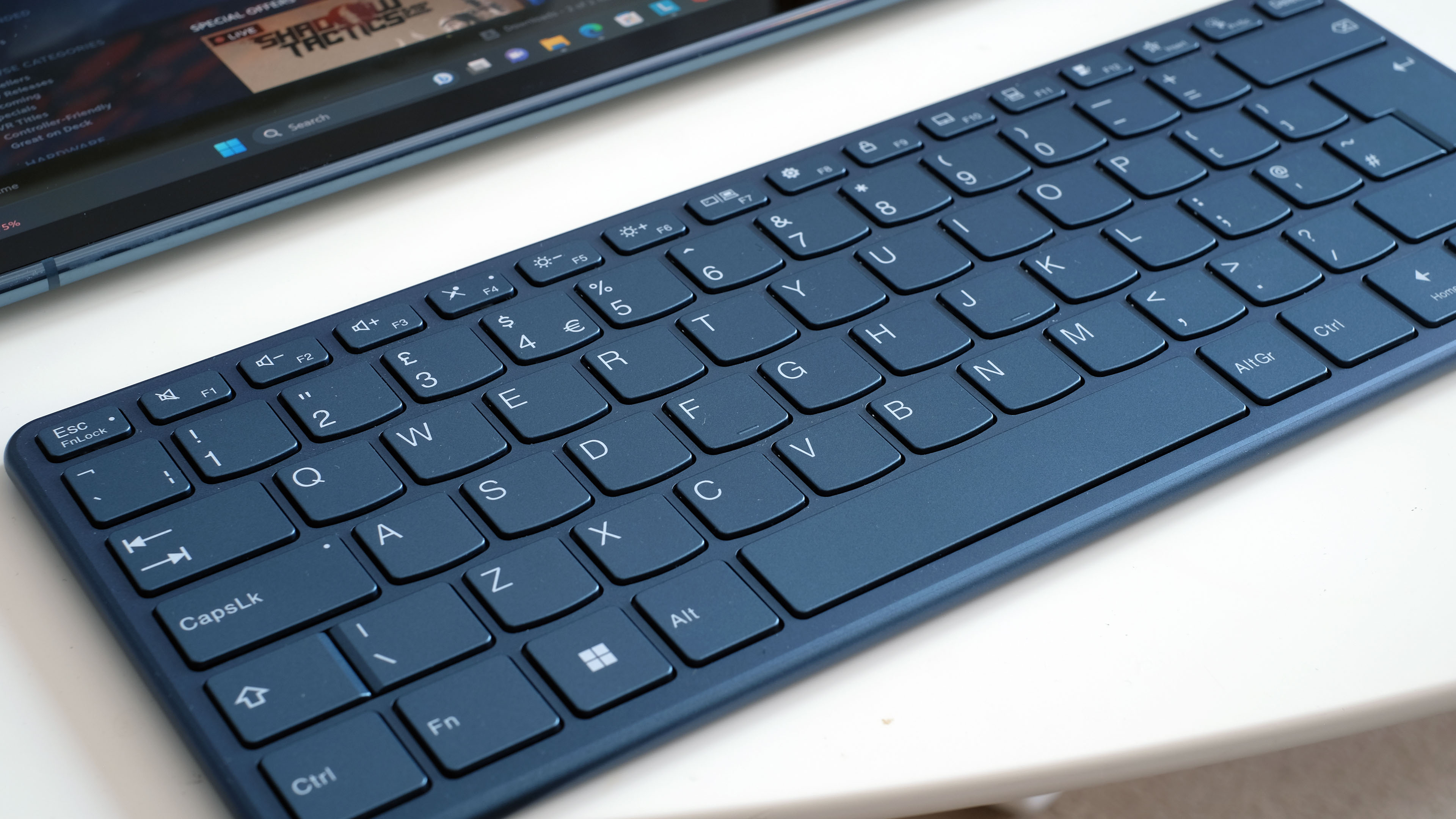
Similarly, virtual keyboards are no replacement for actual keys, because the feedback you get from a little vibration buzz just isn’t anywhere near as satisfying as a true keyboard’s moving bits.
Bringing in the Lenovo Yoga Book 9’s physical keyboard improves the typing experience immeasurably. This thing is pretty good, and we typed a few thousand words of articles on it, no issue. We love how it kinds slots into place on the lower screen thanks to the integrated magnets, and that you can move it around whenever you fancy as it’s wireless.
It’s a shame there’s no touchpad, though. For serious work we’re always going to recommend plugging in a mouse, thanks to the flawed feel of the on-screen virtual pad. The keyboard also lacks a backlight, which seems strange when it already has an integrated battery to power its wireless communication.
Lenovo may have found the battery ran down too quickly with LED lighting, but key backlighting feels like something we should be able to take for granted at this price.
Lenovo Yoga Book 9i review: Performance
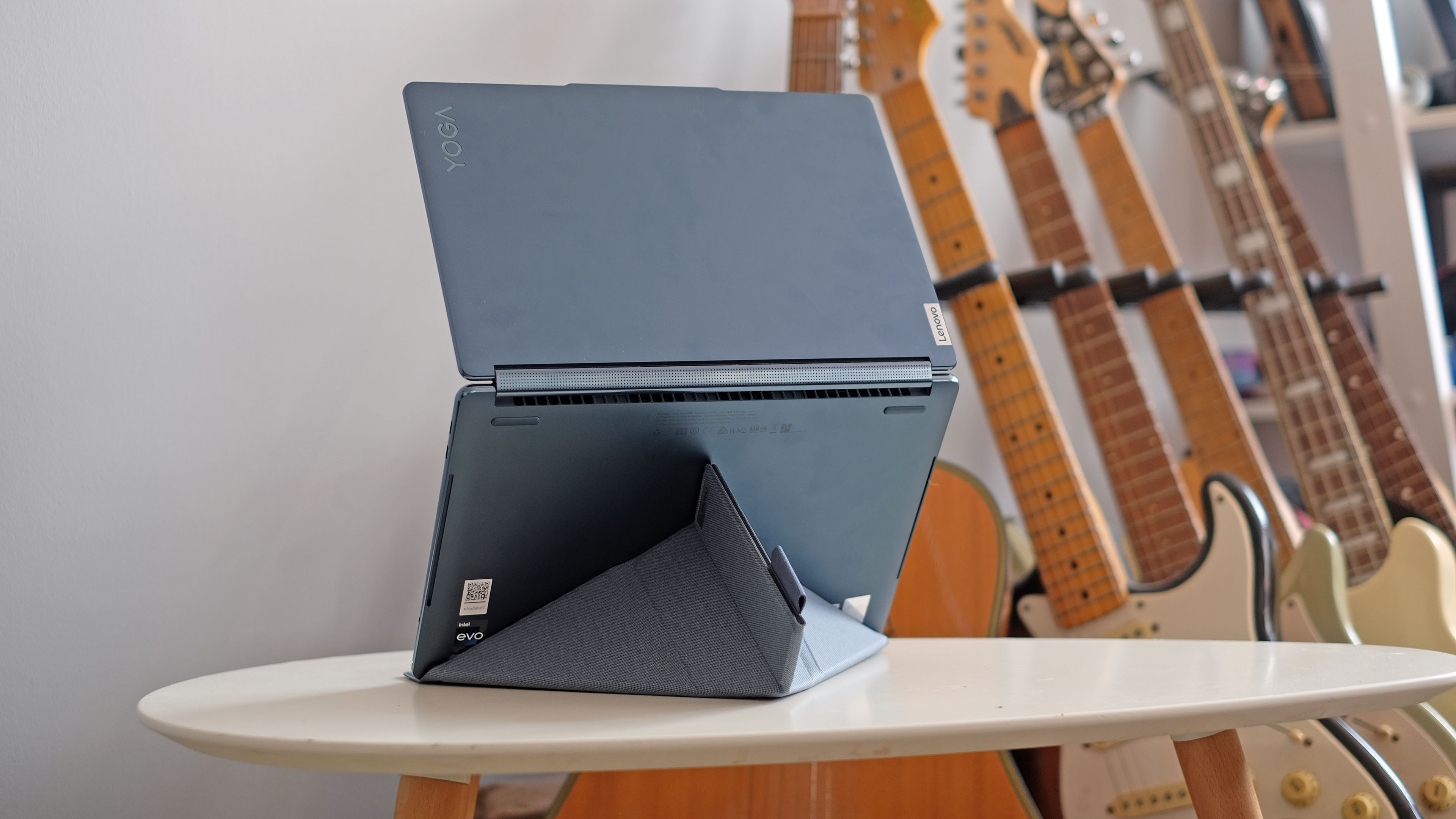
One of the harshest jibes you could level at the Lenovo Yoga Book 9i is that it’s a gimmick, a toy. However, a closer look at its core specs clearly shows it is not one.
This laptop has an Intel Core i7-1355U, 16GB RAM and a 1TB SSD. It’s the least we’d expect for the money, but this is no trumped up tablet and does not use a phone-like processor.
You can have a crack at just about anything on this PC, and the dual-screen design is going to be fantastic for applications that rely on a good amount of screen real-estate. Music production software pops right into our minds here, but that space will come in handy for all kinds of pro-grade suites, for video, images, music and, sure, spreadsheets.
Let’s not get carried away, though. The “U” series processor the Lenovo Yoga Book 9i uses is a low-voltage chipset, designed to not generate too much heat or drink up the battery too quickly.
It will be substantially slower when, say, encoding video than a recent MacBook Pro or the “ordinary” alternative to the Yoga Book, the Lenovo Yoga 9 Pro. Saying that, Windows 11 still sings on this thing.
The laptop doesn’t make too much noise either, which is a pleasant surprise. Yes, the Lenovo Yoga Book 9i has a fan. It’s not like a passively cooled MacBook Air. But the Yoga Book 9i does seem to have had a bit more effort put into lowering operating noise than the average slim-and-lightweight laptop.
This should basically go without saying, but the Yoga Book isn’t one of the best gaming laptops. It has Intel’s respectable Intel Xe graphics, meaning you can play recent titles, even Cyberpunk 2077, if you push the settings and resolution way (way) down... and aren’t too picky about performance either. Still, when you’re spending this much you can get laptops that will play games dramatically better than this one.
Lenovo Yoga Book 9i review: Battery life & features
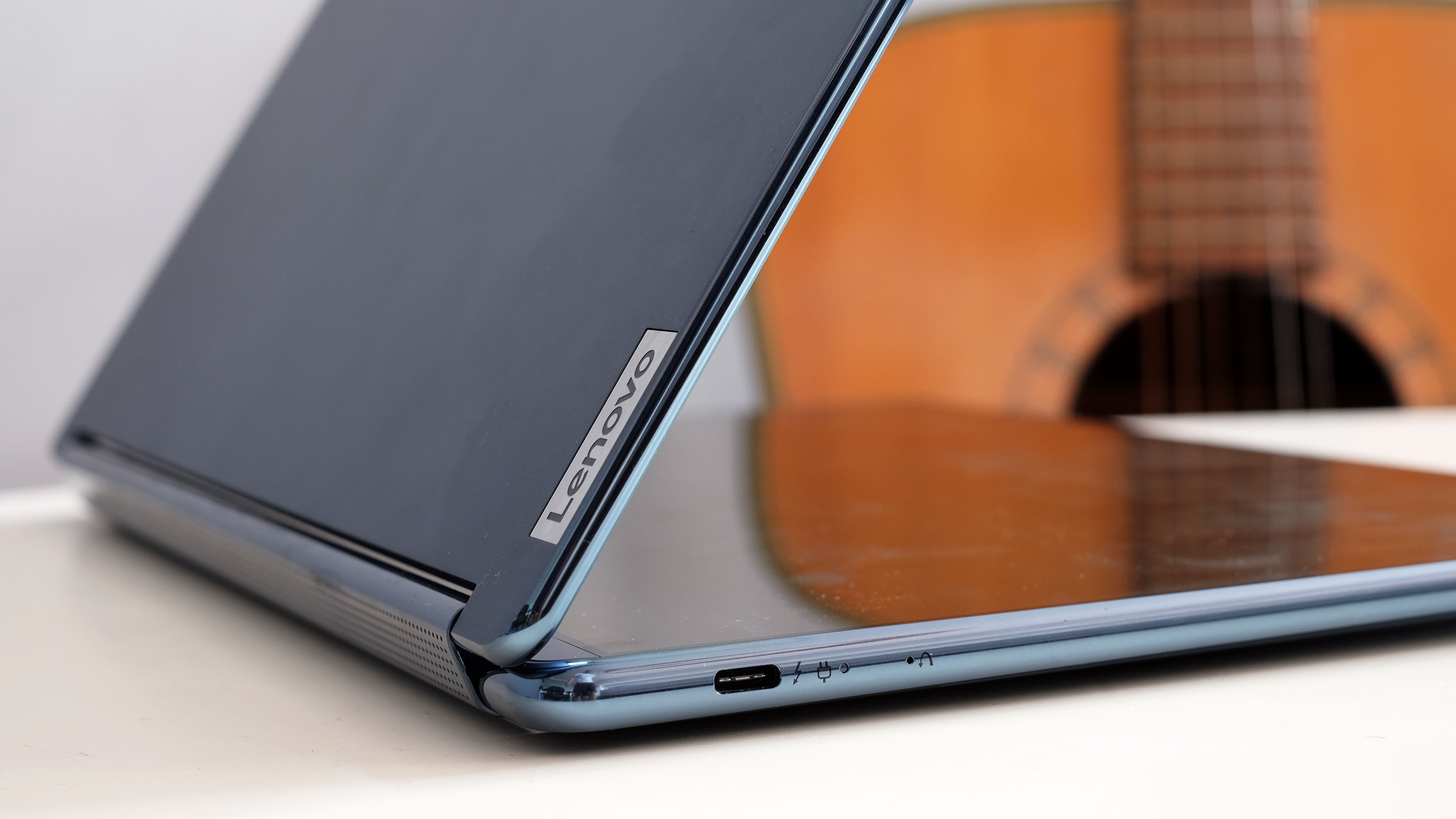
One of the big questions: does the decision to use lower power internals pay off in battery life? It kinda does.
The Lenovo Yoga Book 9i can last up to around 10 hours and 15 minutes when working primarily off the top screen, leaving the lower one to just display the virtual touchpad. In its most laptop-like formulation, it can go head-to-head with some fairly long-lasting ordinary laptops. You can thank the 80Wh battery for that, which is larger than that of most 13-inch laptops.
At maximum brightness, this drops to 8 hours based on our testing, but that's also not a bad result. This is when doing basic productivity jobs, nothing too challenging.
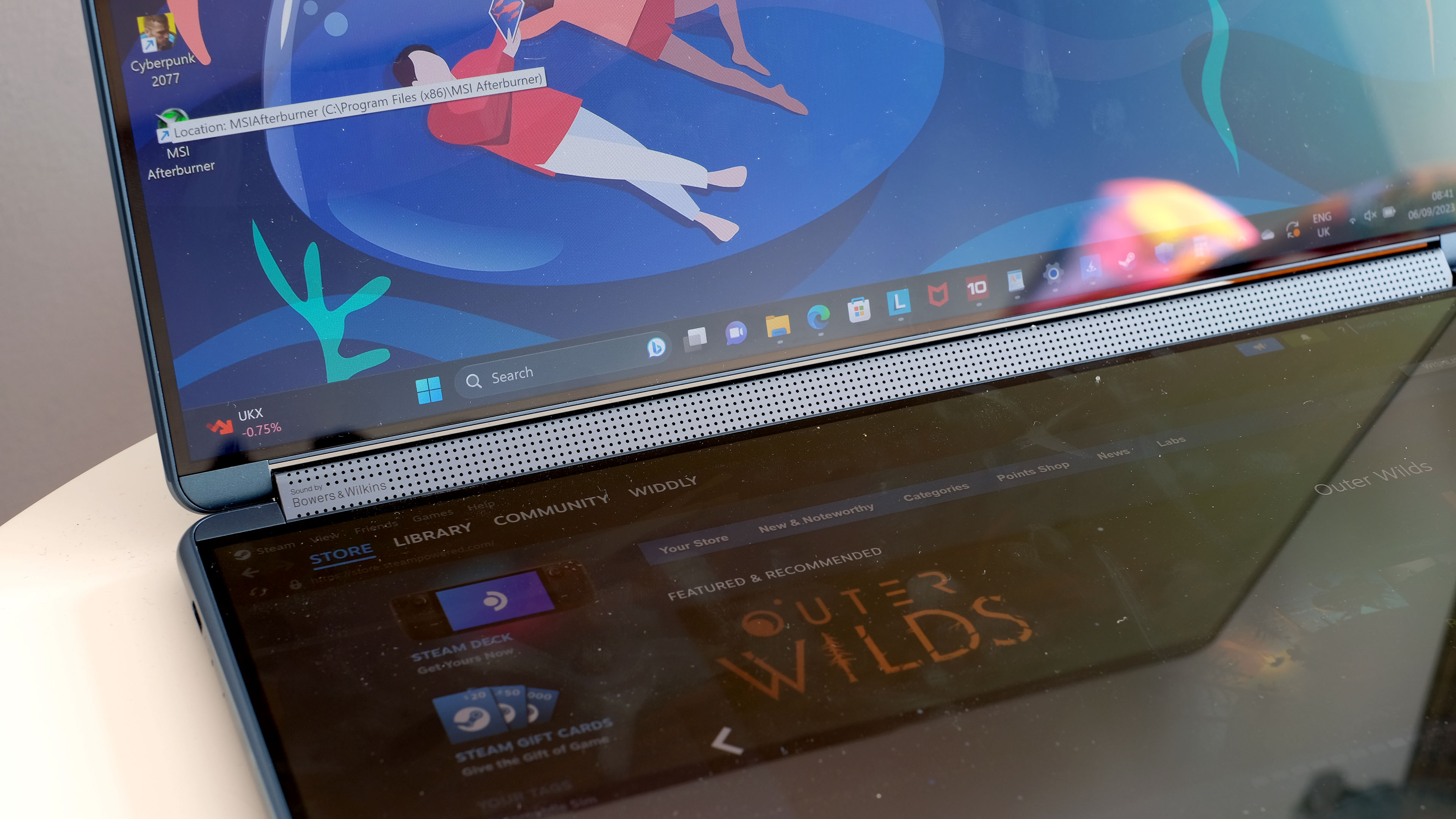
One of Lenovo’s quoted figures is just 7.3 hours, however, giving you an indication of what to expect when running off both screens. It does reckon the Yoga Book 9i will last up to 10 hours of dual-screen video playback though.
The speakers are the bigger boon for movie-watching, though. This array sounds great, with lots of volume on tap and a decent lower-frequency punch. You can see where the speakers live easily enough, in that soundbar between the two displays.
The Lenovo Yoga Book 9i also has an unusual webcam, one with a 5MP sensor instead of the 720p one you’ll probably find on your current laptop, or the 1080p kind that is now the standard for plush laptops. While we weren’t quite an impressed here as by some of the 5MP Microsoft Surface laptops we’ve seen, the 1440p video is still a noticeable step up from 1080p.
Verdict
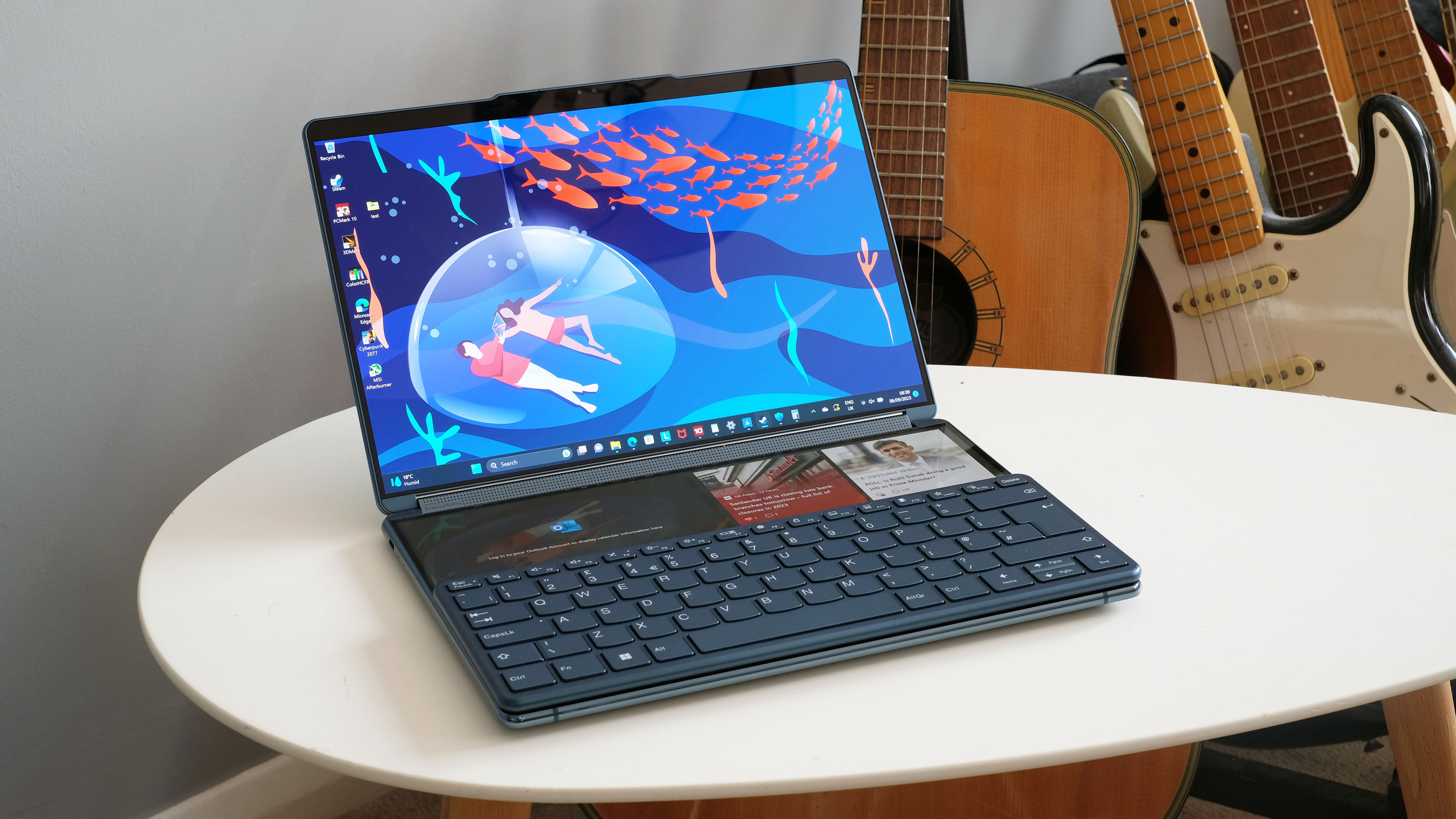
The Lenovo Yoga Book 9i is one of the most interesting laptops we’ve reviewed in 2023. Or even in recent years, come to think of it. But it’s not going to be the most practical pick for many people.
Our main complaint is it often doesn’t feel all that handy to use as a normal laptop when out and about. Working from a pure touchscreen interface? Not much fun. And while taking out the wireless keyboard improves matters a load, that’s not always ideal. Oh, and the glossy glass touchpad? Still rubbish.
The Lenovo Yoga Book 9i shines brightest when working a bit like a dual-screen desktop PC that can be stashed in your rucksack. If that’s what you’re after then welcome to a slice of hybrid-laptop heaven.
Also consider
The clearest alternatives here are from Asus’s Zenbook Duo range. There’s the somewhat gamer-friendly Zenbook Pro Duo 14 and 15, with dedicated graphics cards. Or the cheaper (but much older) Zenbook Duo 14, with a now outdated CPU.
These laptops build two screens into a single body, complete with proper keyboard and mini touchpad. While still a bit wild, there’s less faffing around involved than in the Yoga Book 9i because no add-ons are required.
However, the second screen is much squatter, meaning it doesn’t deliver that classic dual-screen experience, which the Lenovo does mostly manage to reproduce.
Sign up to the T3 newsletter for smarter living straight to your inbox
Get all the latest news, reviews, deals and buying guides on gorgeous tech, home and active products from the T3 experts

Andrew is a freelance tech and entertainment journalist. He writes for T3, Wired, Forbes, The Guardian, The Standard, TrustedReviews and Shortlist, among others.
Laptop and computing content is his specialism at T3, but he also regularly covers fitness tech, audio and mobile devices.
He began writing about tech full time in 2008, back when the Nintendo Wii was riding high and smartphones were still new.
-
 Warning: Ciele’s refreshed Elite Collection may cause excessive garment envy on race day
Warning: Ciele’s refreshed Elite Collection may cause excessive garment envy on race dayFlex on your run crew with Ciele’s latest drop
By Matt Kollat Published
-
 Smeg adds a touch of navy sophistication to its iconic breakfast set
Smeg adds a touch of navy sophistication to its iconic breakfast setIt's a minimalist's dream
By Lizzie Wilmot Published
-
 My most anticipated Netflix movie of the year gets a wild new trailer
My most anticipated Netflix movie of the year gets a wild new trailerHavoc looks pretty unbelievable
By Max Freeman-Mills Published